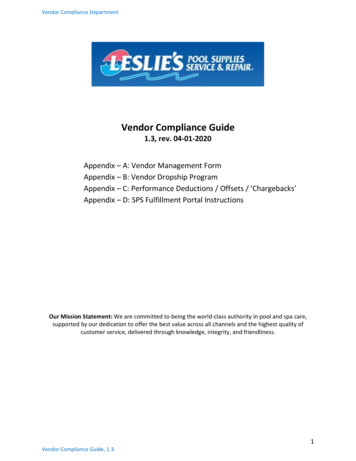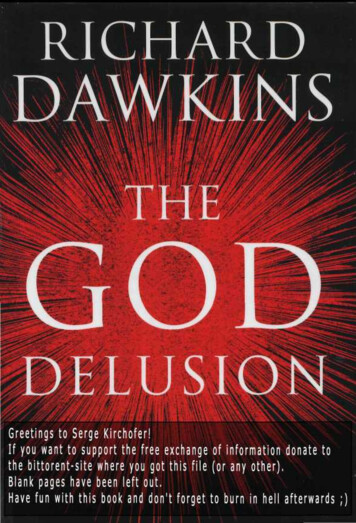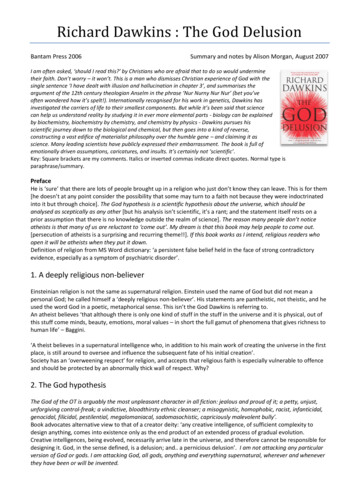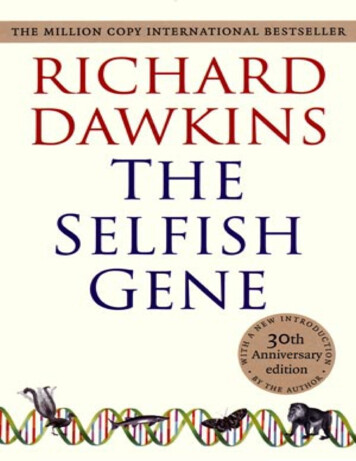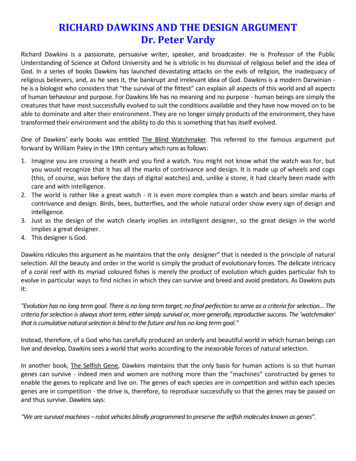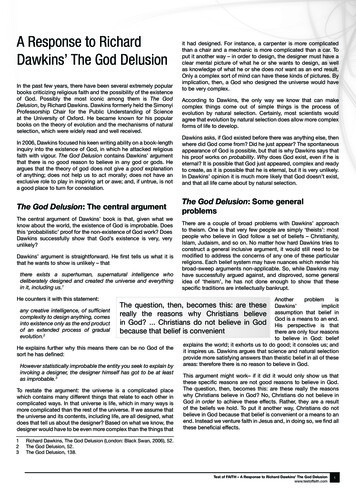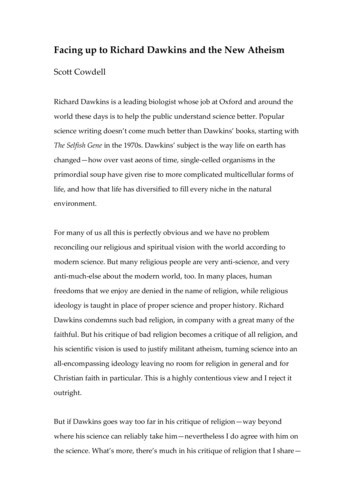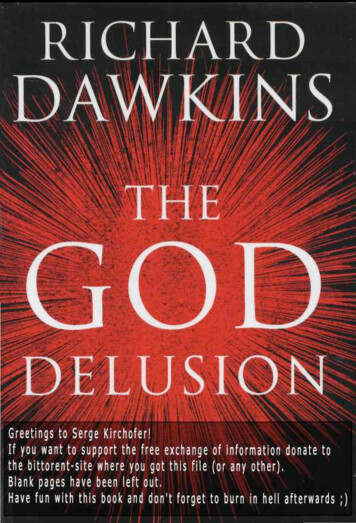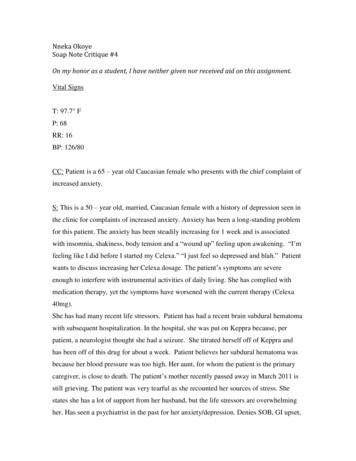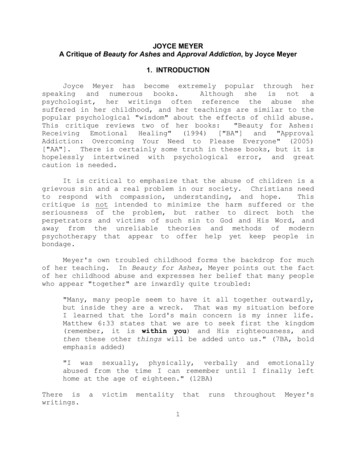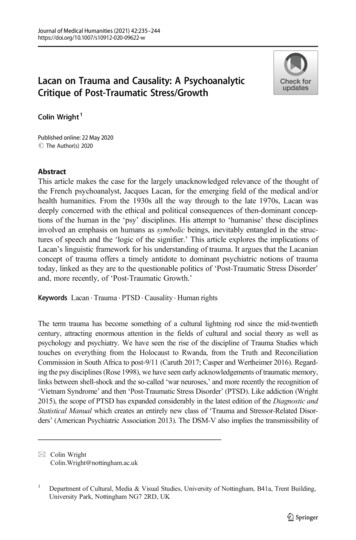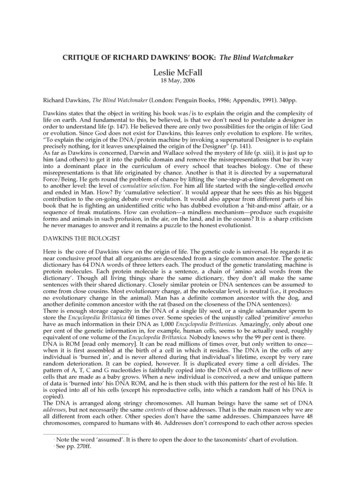
Transcription
CRITIQUE OF RICHARD DAWKINS’ BOOK: The Blind WatchmakerLeslie McFall18 May, 2006Richard Dawkins, The Blind Watchmaker (London: Penguin Books, 1986; Appendix, 1991). 340pp.Dawkins states that the object in writing his book was/is to explain the origin and the complexity oflife on earth. And fundamental to this, be believed, is that we don’t need to postulate a designer inorder to understand life (p. 147). He believed there are only two possibilities for the origin of life: Godor evolution. Since God does not exist for Dawkins, this leaves only evolution to explore. He writes,“To explain the origin of the DNA/protein machine by invoking a supernatural Designer is to explainprecisely nothing, for it leaves unexplained the origin of the Designer” (p. 141).As far as Dawkins is concerned, Darwin and Wallace solved the mystery of life (p. xiii), it is just up tohim (and others) to get it into the public domain and remove the misrepresentations that bar its wayinto a dominant place in the curriculum of every school that teaches biology. One of thesemisrepresentations is that life originated by chance. Another is that it is directed by a supernaturalForce/Being. He gets round the problem of chance by lifting the ‘one-step-at-a-time’ development onto another level: the level of cumulative selection. For him all life started with the single-celled amoebaand ended in Man. How? By ‘cumulative selection’. It would appear that he sees this as his biggestcontribution to the on-going debate over evolution. It would also appear from different parts of hisbook that he is fighting an unidentified critic who has dubbed evolution a ‘hit-and-miss’ affair, or asequence of freak mutations. How can evolution—a mindless mechanism—produce such exquisiteforms and animals in such profusion, in the air, on the land, and in the oceans? It is a sharp criticismhe never manages to answer and it remains a puzzle to the honest evolutionist.DAWKINS THE BIOLOGISTHere is the core of Dawkins view on the origin of life. The genetic code is universal. He regards it asnear conclusive proof that all organisms are descended from a single common ancestor. The geneticdictionary has 64 DNA words of three letters each. The product of the genetic translating machine isprotein molecules. Each protein molecule is a sentence, a chain of ‘amino acid words from thedictionary’. Though all living things share the same dictionary, they don’t all make the samesentences with their shared dictionary. Closely similar protein or DNA sentences can be assumed tocome from close cousins. Most evolutionary change, at the molecular level, is neutral (i.e., it producesno evolutionary change in the animal). Man has a definite common ancestor with the dog, andanother definite common ancestor with the rat (based on the closeness of the DNA sentences).There is enough storage capacity in the DNA of a single lily seed, or a single salamander sperm tostore the Encyclopedia Brittanica 60 times over. Some species of the unjustly called ‘primitive’ amoebashave as much information in their DNA as 1,000 Encyclopedia Brittanicas. Amazingly, only about oneper cent of the genetic information in, for example, human cells, seems to be actually used, roughlyequivalent of one volume of the Encyclopedia Brittanica. Nobody knows why the 99 per cent is there.DNA is ROM [read only memory]. It can be read millions of times over, but only written to once—when it is first assembled at the birth of a cell in which it resides. The DNA in the cells of anyindividual is ‘burned in’, and is never altered during that individual’s lifetime, except by very rarerandom deterioration. It can be copied, however. It is duplicated every time a cell divides. Thepattern of A, T, C and G nucleotides is faithfully copied into the DNA of each of the trillions of newcells that are made as a baby grows. When a new individual is conceived, a new and unique patternof data is ‘burned into’ his DNA ROM, and he is then stuck with this pattern for the rest of his life. Itis copied into all of his cells (except his reproductive cells, into which a random half of his DNA iscopied).The DNA is arranged along stringy chromosomes. All human beings have the same set of DNAaddresses, but not necessarily the same contents of those addresses. That is the main reason why we areall different from each other. Other species don’t have the same addresses. Chimpanzees have 48chromosomes, compared to humans with 46. Addresses don’t correspond to each other across species1212Note the word ‘assumed’. It is there to open the door to the taxonomists’ chart of evolution.See pp. 270ff.
barriers. Closely related species, however, like chimps and humans, have large chunks of adjacentcontents in common. The thing that defines a species is that all members have the same addressingsystem for their DNA.When a sperm fertilizes an egg, a full complement of 46 chromosomes is made up, and all 46 are thenduplicated in all the cells in the developing embryo.ROM cannot be written to, except when it is first manufactured and that is true also of DNA in cells,except for occasional random errors in copying.Cows and pea plants have an almost identical gene called the histone H4 gene. The DNA text is 306characters long. Cows and peas differ from each other in only two characters out of these 306. Theyhad a common ancestor 1,000 to 2,000 million years ago. The copying of the DNA was so accurateover this time that it is the equivalent of making only one error in copying the Bible 250,000 times.The probability of any one particular letter [of the DNA code] being miscopied on any one copyingoccasion turns out to be a little more than one in a billion. DNA replicates so accurately that it takesfive million replication generations to miscopy one per cent of the characters. This is the equivalent of20 billion typists each typing out the New Testament making only one error each. But the DNAcopying mechanism automatically corrects its own mistakes. It has its own ‘proof-reading’ drills.About 5,000 DNA letters degenerate per day in every human cell, and are immediately replaced byrepair mechanisms. It is mainly ‘proof-reading’ that is responsible for DNA’s remarkable accuracyand fidelity of information storage.What was the basic ingredient needed for life to emerge? Answer: It is the property of self-replication.In modern life this role is fulfilled almost entirely by DNA molecules. The issue for Dawkins is thatfor evolution to occur “at least some of the DNA replicators had to exert power over their own future”(p. 129). And this is his basic problem: the DNA obey instructions; they do not create them. But whoor what set up the instructions in the first place? Dawkins can only suggest it was chance. That is abig ask.THE BLIND WATCHMAKERDawkins acknowledges that single step changes are random, but cumulative steps are not. This is adeceptive statement as we shall see. Darwinism is a theory of cumulative processes, he argues, soslow that they take between thousands and millions of decades to be noticeable (p. xv). He notes thatall appearances to the contrary, the only watchmaker in nature is the blind forces of physics. A truewatchmaker has foresight, with a future purpose in his mind’s eye.Natural selection, the blind, unconscious, automatic process which Darwin discovered, and which we nowknow is the explanation for the existence and apparently purposeful form of all life, has no purpose in mind. Ithas no mind and no mind’s eye. It does not plan for the future. It has no vision, no foresight, no sight at all. If itcan be said to play the role of watchmaker in nature, it is in the blind watchmaker (p. 5).And again, “Natural selection is the blind watchmaker, blind because it does not see ahead, does notplan consequences, has no purpose in view. Yet the living results of natural selection overwhelminglyimpress us with the appearance of design . . . with the illusion of design and planning” (p. 21). Andagain, “In the case of living machinery the ‘designer’ is unconscious natural selection, the blindwatchmaker” (p. 37). The problem with this analogy is that blind watchmakers could make a watchevery bit as perfect as a sighted watchmaker. So the force of the analogy is lost unless by it he meansthat a blind watchmaker is totally incapable of producing a watch at all, in which case he is not awatchmaker. ‘Blind’ and ‘watchmaker’ do not go together to make a meaningful entity, in Dawkins’analogy.For the Christian, the ‘Watchmaker’ is God and He is not blind, but with infinite wisdom He has setthe sun, moon and stars in their courses to serve the Earth. Nothing has come into existence which hasnot come through His hands. So detailed is God’s interest in every creature that He created thatalthough two sparrows are sold for a farthing yet not one of them falls to the ground without yourFather knowing about it (Matt. 10:29). He is not a blind Watcher. Even the very hairs of our head areall numbered, and then comes the reassuring and logical conclusion: “Fear not therefore, you are ofmore value than many sparrows” (Luke 12:7).The question evolutionists are unable to answer is this: If ‘natural selection’ is a purely randomaffair—because it is at the mercy of fortuitous mutations—then how come that millions of animalsand plants have all come to the peak of their development all at the same time? Why are there notmillions of animals still only half-way through their ultimate complexity? Where are the intermediateforms today?2
Dawkins finds ‘design’ and ‘evident planning’ a paradox if evolution is without purpose. Evolution isnot directional. Each single step in evolution is a random step, and the next step is also random, andso it goes on infinitum, and the evolutionist hopes that a sufficient number of these random steps willlead in an upward direction to greater complexity. But on this scenario one wrong step could undo asequence of what looked like a single or even cumulative ‘beneficial’ step.Because evolution is inherently directionless and purposeless, it is pure chance that any sequence ofsingle steps could result in a minor cumulative ‘development’. And if you have to string a million,individual, chance steps together to get a coelacanth to leave the deep ocean bed, where it is totallyadapted to survive, and take its first faltering steps on land, it is a big ask. There is no scienceavailable today that could map out one single step of a journey involving a correct sequence of amillion random steps to get from coelacanth to modern man.DAWKINS’ ESCAPE INTO ‘CUMULATIVE SELECTION’We noted above Dawkins’ deceptive statement that single step changes are random, but cumulativesteps are not. There is a fatal flaw at the heart of Dawkins’ escape into ‘cumulative selection’. Theflaw is this. Cumulative selection is not an event, it is a summary of events, and those events can onlybe one-step-at-a-time steps. He dislikes intensely the argument that all came into existence by chance.He senses that this is not a winning argument, so the ploy is to group a series of single steps into onebig single ‘cumulative step’ and get round the problem that way. It then looks as if chance has beenruled out. But what does he say? “Each successive change in the gradual evolutionary process wassimple enough, relative to its predecessor, to have arisen by chance” (p. 43). He continues, “But thewhole sequence of cumulative steps constitutes anything but a chance process, when you consider thecomplexity of the final end-product relative to the original starting-point. The cumulative process isdirected by non-random survival” (p. 43). Hindsight is a wonderful thing! But even hindsight has toadmit that it was a freak set of millions of chance mutations that produced every single end-productthat has come through the process. Presumably billions of billions of end-products never made it. For‘natural selection’ read ‘freak set of circumstances’ and this would capture the miracle of life on Earth.The evolutionist believes that life started with bacteria and then through millions of mutations movedfrom coelacanth to man. If a man can believe that, which has no credible science to back it up, he is nofurther on than the Lamarckian evolutionist.Despite his protestations that evolution is not a random result, Dawkins is thrown back on Darwin’smillions of microscopic changes over millions of years to make evolution credible. Dawkins cannotget away from this ‘solution’, even with his statement that his ‘cumulative selection’ is a non-randomprocess (p. 49). These are just words. The proof is that all the end-products are random products ofevolution, because evolution is inherently directionless, motiveless, purposeless, mindless. It is just aseries of chance chemical reactions. It is just like a monkey bashing away on a typewriter, oblivious ofwhat he is typing.If Dawkins does not know it, the reader does, that while the effect may be cumulative, the process ismade up of single-step changes. It is a fallacy to say that development moved from one ‘cumulativeselection’ change to another ‘cumulative selection’ change, because there is no such thing as a ‘cumulativeselection’ change, because change can only occur at a rate of one-step-at-a-time throughout themovement from the single-celled amoeba to the most complex of all creatures—Man. He makes thetelling observation, “If evolutionary progress had had to rely on single-step selection, it would neverhave got anywhere” (p. 49). Also, “The ‘watchmaker’ that is cumulative natural selection is blind tothe future and has no long-term goals” (p. 50).What Dawkins should be arguing for, then, is ‘multiple-step’ mutations, but he knows only too-wellthat this is fraught with danger for evolutionary progress (cf. p. 233). Too much change too fastwould leave the fish floundering on the beach gasping for air. He has no option but to retreat tosingle-step evolution because this is more believable and he feels he can bring along his readersprovided he does not stretch their incredulity too far, too quickly. He is not so much searching for thetruth about the origin of life, as searching for a theory that is intellectually plausible, and statisticallyprobable. This is his favourite ploy.DAWKINS’ ESCAPE INTO STATISTICAL PROBABILITYBecause ‘cumulative selection’ is a statement about progress, at any point in the evolutionarydevelopment, Dawkins is thrown back on single-step, random mutations, which he desperatelywants to avoid, to sustain momentum toward complexity. Aware that talk about ‘non-randomcumulative selection’ is fatally flawed, Dawkins takes cover in statistical probability. He notes that for3
one monkey to type the Shakespearian line, “Methinks it is like a weasel,” the chances are 1 in 10,000million million million million million (p. 46). The flaw in this analogy is that the monkey is randomlybashing away on his typewriter with a target to achieve. There is no such target, either near ordistant, in evolution. Evolution is totally blind. All changes are purely fortuitous and if somethinghappens which is not detrimental, then it is a freak outcome. Dawkins agrees, “If, after the aeons,what looks like progress toward some distant goal seems, with hindsight, to have been achieved, thisis always an incidental consequence of many generations of short-term selection” (p. 50).However long the odds, Dawkins still believes the monkey can achieve his goal. The aptness of thisanalogy is that just as a monkey can have no idea what he is typing, and couldn’t even read it whenhe did achieve it, or have any sense of achievement, so likewise is it with evolution. It may be possiblefor the monkey to achieve his goal because he, at least, has a machine to work with, but he can neverknow when he has successfully managed to type out the sentence! He just keeps going past thesuccessful moment without even being aware of it! But if our monkey was given an electrictypewriter with no electricity, the odds are then zero.There is a mechanism in nature whereby a mountain can evolve into a mole-hill over millions ofyears, but there is no mechanism whereby a mountain can evolve into a mole. So it is with themachinery Dawkins is attempting to use to get from an amoeba to Man. He is using a machine whichis not ‘switched on’ to get the ‘letters’ of the genetic code into the right sequence. This is the dilemmahe and all evolutionists are faced with. (But more on this topic below.)Another statistical example is his observation that there are about 100 billion billion earth-like planetsin the universe, but life, so far, has only succeeded on one of them. Fortunately, a colleague pointedout the fallacy of the analogy (p. 142) and so he dismisses the statistical probability as an assumption.Nevertheless, he still thinks life has occurred elsewhere in the universe!The statistical probability of producing sonar is small. But it happened. The sophistication of batsonar is summed up as the work of natural selection working on bats over a period of “tens ofmillions of years” (p. 23). Nothing is said of misdirected ‘cumulative selection’ resulting in theextinction of directionless evolution. Why is it that the evolution of all things so far has ended up in astasis state, which is the terminus all living forms have arrived at today. Evolution is not happeninganywhere, in any plant or animal in the world today. Each organism now stays within its allotted “kind”.All creation has reached a stage that it cannot be improved upon. That is a fact of observation. Thatstage was a created stage, not an evolutionary stage. Both Creationism and Darwinian evolution areinterpretations of a creation that now displays a pinnacle of near-perfect replication of itself. I trustevolutionists are not looking for a super-human to develop out of homo sapiens. Hitler’s ‘super-race’was fuelled by philosophical evolutionism. Huge variety of human beings exist (dwarfs and giants)but all share the same DNA addresses. Huge variety of dogs and cats exist. So what? If the capacity tovary was not inherent in the cell from the beginning, then the variety could not come into existence.The Creationist (the ‘spiritual man’) looks at this pinnacle of near-perfect replicating ‘after its kind’ asbeing the same today as it was when it left the hand of its Creator ‘in the beginning’. The evolutionist(the ‘natural man’) looks at the same pinnacle of replicating-perfection and believes it got there littleby little over millions of years. But neither the Creationist nor the Evolutionist can deny that whatthey are looking at is replicating-perfection (within the context of a ‘fallen’ world) in every form ofliving organism on the planet Earth today. That is not to deny that the Creator has built in to Hiscreation His wisdom to enable each species to survive within the limits of adaptation which He set forit ‘in the beginning’.Molecular taxonomists recognise that there are barriers in nature that cannot be crossed.“Chimpanzees, for instance, have 48 chromosomes compared to our 46. Strictly speaking it is notpossible to compare contents, address by address, because addresses don’t correspond to each otheracross species barriers” (p. 118). This is the hard fact of science that evolutionists have no way ofgetting round today, as Dawkins’ writhings and twistings demonstrate in this book. He never didgive his readers the solution to the origin of complexity that he said he was setting out to give them.Darwin lived in an age of ignorance of what was going on at the DNA level, and consequently hecould only work from the end-product, not from the beginning—from the constitution of the cell andthe universe of complexity that science, since his day, has brought to light. Darwin may have hit onthe right solution but it was not a scientific one. Some think he was right but for the wrong reasons.Modern evolutionists are running to catch up and give him a credible scientific basis for his intuition.But the science is falling short of being able to supply the missing link at the biological end, namely,the missing machine to create a self-replicating molecule, which the present DNA machine cannotfulfil. Science is stuck fast at this point. It has come up against a blank wall. But it still clings firmly toan out-dated, pre-scientific, Victorian theory which had its origin in bad science. Evolution is ahangover from a time when the gullible, academic community had to jump on its bandwagon or be4
thought of as unscientific. It gave its follower academic respectability and that was more importantthan listening to God’s revelation. Academic respectability is still keeping evolution alive today. Ithas no hard science behind it. Even Christians in science are still heard to say that it is “best theory wehave for the origin of life”. But the ‘natural man’ cannot let go of evolution. It is all he has got left toprevent him acknowledging that there is a Creator God, and that the creation reflects His power andHis Godhead (Rom 1). Rather than fall down on his knees and worship the Creator, he would preferto stay on his wobbly feet using the two wobbly crutches of Darwin’s unscientific speculation underone arm, and the Neo-Darwinian crutch of so-called modern science under the other arm, to keep himoff his knees. He is a pitiable sight—a pitiable creature, blinded by his own crumb of science. Alwayslearning but never able to arrive at the Truth. “Walk in the light,” Jesus urged His disciples. His totaldependence on the written Word of God is the model to follow. The question Jesus will be asking themajority of Christians in science who favour evolution is: Why did you not trust what my Fatherwrote for you, as I did? Why did you prefer a mere, human theory over a clear divine statement of thefacts? Evolution would never occur to a Christian who had faith in a Creator God and who trustedthe revelation he was given in Genesis 1-3. Consequently, a Christian who holds to evolution is adamaged Christian, and damaged for life. He cannot ever be trusted to be a guide to the blind,because he himself is blind.THE SIGNIFICANCE OF THE BIBLICAL STATEMENT ‘AFTER ITS KIND’A bat would be deafened by its own out-going signal but it has an incredible ‘send/receive’ switchingmechanism which prevents this. Now, since Dawkins ridicules Lamarckian evolution, how did thefirst bats avoid deafening themselves before they ‘acquired’ the safety mechanism? They should all bedeaf. Lamarckian evolution believed that because giraffes kept stretching their necks to reach theupper leaves of trees, gradually their necks got longer and longer because there was a free meal to behad up there. This has rightly been ridiculed by all biologists. It is stupid, but not less so than thebelief that a fish can somehow develop into a man by a process which is nowhere happening today,anywhere in the world, because the DNA machinery is an obstacle to it!Environmentally acquired skills cannot enter the DNA machinery and be passed on to the nextgeneration. Whatever is acquired after birth must continue to be acquired after birth in all species. Andwhatever is pre-programmed before birth will continue to be pre-programmed before birth in allspecies. That is the strength that lies in the biblical phrase “after its kind.” It will never be otherwise.In this science and the Bible agree.Take for instance the discovery in 1938 off the South African coast of a fish belonging to thecoelacanth group. This fish has unusual leg-like fins. More of the same fish have been found sincethen, so it is not a one-off find. “It is a ‘living fossil’, in the sense that it has changed hardly at all sincethe time of its fossil ancestors, hundreds of millions of years ago,” to quote Dawkins (p. 246). It wasthought (to go by the absence of any fossils of it in all the later geological strata) to have died out withthe dinosaurs, with whom it was contemporary, 250 million years ago. The discovery of thecoelacanth was a huge embarrassment to evolutionists, but Dawkins dismissed it as an extreme case(cf. p. 246). Extreme or not, it is a hard fact of science. He goes on to speculate that other coelacanth“that emerged unto the land did evolve because natural selection . . . forced them to” (p. 246). But wesaw above that ‘natural selection’ selects nothing. It is not a force and it forces no fish out of the waterunto dry land.On page 273 Dawkins gives a taxonomist’s chart showing which animals have developed from whatstock. From the Coelacanth the following modern day animals have descended through millions ofmutations: cats, tigers, dogs, foxes, lemurs, baboons, Rhesus monkeys, gibbons, chimpanzees andhome sapiens. But there is a single, fatal flaw in this chart, namely, there is no mechanism whereby asingle mutation can take place today between any two animals which could open the door toevolution. If evolution cannot make the first step, then how could it make millions of steps startingwith a fish and ending up with a man?In any case, dogs replicate dogs and not kittens. All taxonomy is based on the following ecies:Sapiens5
The problem with such ‘tree relationships’ is that, “It has been calculated that the fastest of today’scomputers would take 10,000 million years, approximately the age of the universe, to discover themost parsimonious tree for a mere 20 animals” (p. 273). If there are millions of species how is itpossible to incorporate them all into any tree relationship?Pierre-P. Grassé has shown that once a development has reached the species level it cannot developinto any other species. God created ‘species’ not phylum or the other biologists/taxonomistscategories. It is an artificial imposition to have these six categories, and in attempting to do so on thebasis of DNA leads to silly tree relationships, such as that between the cow and the pea plant. Genesisonly recognises one tree relationship for each plant and animal—that of distinct species—No. 6. Onceyou go beyond that categorisation you enter silly-land.The polar difference between Creationism and Evolution is this. Evolution starts off with a singlecelled organism which then evolved into millions of complex beings. Creationism starts off withmillions of complex beings, which are gradually being reduced to extinction. Evolution moves fromzero to millions; Creationism moves from millions to zero. For one the glass is half full; for the otherthe glass is half empty.3WHERE IS THE MECHANISM TO ACHIEVE SUCCESSFUL MUTATIONS?Dawkins recognises that the only machinery which evolution can use today to manufacturemutations is the DNA/protein machinery. But he notes that the chances of a mutation occurring withthe present DNA set-up is of the order of one in a million against a successful hereditary variationoccurring. In Dawkins’ own words: “In real life, the probability that a gene will mutate is often lessthan one in a million” (p. 57). If that is the odds against one mutation being successful, what must theodds be if this has to be repeated millions of time and in the correct sequence? The probability is thenearest thing to zero that one could conceive of.‘NATURAL SURVIVAL’ OR ‘NATURAL SELECTION’?Dawkins requires mutations to ‘drive’ evolution, but he puts his finger on the problem of mutation.He noted: “But natural selection doesn’t choose genes directly, it chooses the effects that genes have onbodies” (p. 60). In other words mutations are random, but if they do not harm the host body, themutated genes automatically survive because they are inside the body (p. 57). And this process can goon indefinitely so long as no mutation produces an effect that leads to its extinction. This is whatDawkins means by ‘natural selection’ acting like an agent, and choosing the effects that survive eachmutation change. But Dawkins is aware that evolution cannot choose the mutation itself, as these arepurely random. So it is a statement of the obvious to say that if a mutation is not harmful then itsurvives; and if it survives it is only because the mutation was not a damaging one! Call it ‘naturalselection’ or call it common sense, the result is the same.‘Natural selection’ selects nothing. It just tells us that the mutation did not lead to its extermination.What survives will only continue to survive up until a mutation comes along which leads to itsextinction. On this scenario, every living thing is at the mercy of the next mutation. Every mutation isa potential exterminator, that is how fragile living with mutations is. Look again at Dawkins’statement: “But natural selection doesn’t choose genes directly, it chooses the effects that genes haveon bodies” (p. 60). ‘Natural selection’, he believes, chooses the genes indirectly but only in the sensethat they survive in the mutated animal. If the mutated animal is not harmed by the mutation, then itsurvives. Again, this is a statement of the obvious. But ‘natural selection’ does not even choose the‘effects’ that genes have on bodies.The continuation or noncontinuation of any species should be called ‘Natural Survival’, not ‘NaturalSelection.’ Nature selects nothing. A logical evolutionist would observe that it is single, randommutations that have determined, and will continue to determine what will survive and what will notsurvive. It is a misnomer to call this process ‘natural selection’, because selection involves choice.With mutating genes the issue is only between ‘survival’ and ‘nonsurvival’; between (if we must statethe obvious) ‘natural survival,’ and ‘natural nonsurvival.’ If an animal survives it is not because itwas selected to survive, as if Nature selected it, but only because it did not undergo a mutation thathalted or interfered with its survival state.The theory should have been called the Theory of Natural Survival, and simply stated would read:All living forms wil
Richard Dawkins, The Blind Watchmaker (London: Penguin Books, 1986; Appendix, 1991). 340pp. Dawkins states that the object in writing his book was/is to explain the origin and the complexity of
